Table of Contents
- 1 Introduction to First Aid and Medical Supplies for Preppers
- 2 Essentials of a Prepper’s First Aid Kit
- 3 Advanced Medical Supplies
- 4 Organizing Your Medical Kit
- 5 First Aid Skills and Knowledge for Preppers
- 6 Specialty First Aid and Medical Kits for Different Scenarios
- 7 Technological Aids and Resources
- 8 Community and Mutual Aid
- 9 Final Remarks on First Aid and Medical Supplies for Preppers
- 10 Frequently Asked Questions
- 10.1 Is it essential for preppers to have a well-stocked first aid kit?
- 10.2 What are the key items that should be included in a prepper’s first aid kit?
- 10.3 How can one organize their medical kit effectively?
- 10.4 What skills should preppers focus on developing related to medical emergencies?
- 10.5 Are there specialized first aid kits available for specific emergency scenarios?
Views: 5
Introduction to First Aid and Medical Supplies for Preppers
Overview of the importance of first aid and medical supplies in prepping
DISCLAIMER: If you or someone you know may need medical attention you should always seek professional help, first aid is mostly meant to stabilize until you can get proper treatment!
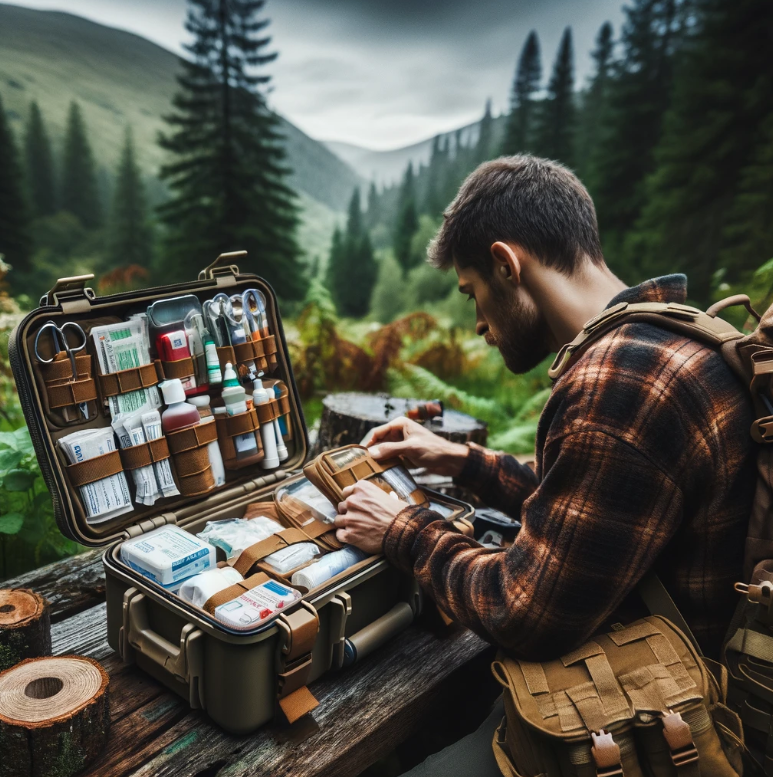
First aid and medical supplies are essential for preppers to manage injuries and medical emergencies effectively. Being prepared with the right supplies can be life-saving during critical situations. A well-equipped first aid kit is a crucial component of any prepper’s emergency readiness strategy.
Preppers need to have a comprehensive first aid kit that includes various medical supplies to address different types of injuries and illnesses promptly. This kit should offer immediate care until professional medical assistance is accessible. It must encompass essentials for basic wound care, trauma management, and common health conditions.
Essentials of a Prepper’s First Aid Kit
Basic components: bandages, antiseptics, tweezers, scissors, etc.
Bandages are crucial for covering wounds and controlling bleeding. They come in various sizes and types like adhesive strips or gauze pads. Antiseptics such as hydrogen peroxide or alcohol wipes are vital for cleaning wounds to prevent infections. Tweezers and scissors play essential roles in removing splinters, cutting tape, or trimming bandages accurately. Emergency preparedness kits are critical!
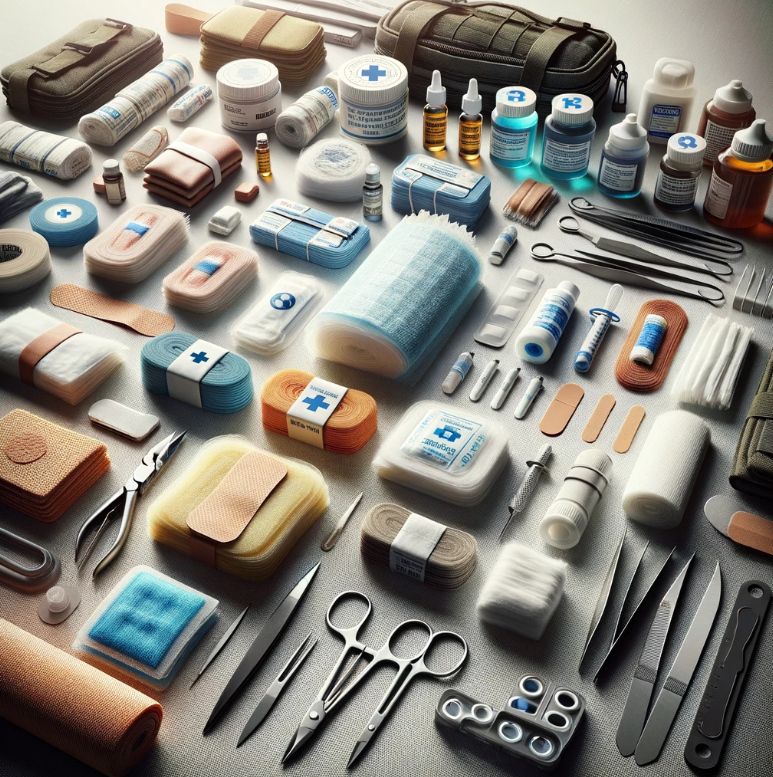
When assembling a first aid kit for prepping purposes, including these basic components ensures you can address common injuries effectively. For example, having different sizes of bandages allows you to cover small cuts as well as larger wounds securely. Keeping antiseptic wipes handy enables quick wound cleaning when access to soap and water is limited.
Specialized items: tourniquets, hemostatic agents, burn dressings
Tourniquets are critical tools for stopping severe bleeding quickly during emergencies by applying pressure on the affected limb above the injury site. Hemostatic agents, such as gauze impregnated with clotting substances like chitosan or kaolin help promote blood clotting swiftly to control excessive bleeding efficiently. Burn dressings provide specialized care for burns by cooling the affected area and protecting it from contaminants while alleviating pain.
Including specialized items like tourniquets and hemostatic agents in your prepper’s first aid kit prepares you to handle more severe injuries effectively until professional medical help arrives. For instance, having a tourniquet ready could be life-saving in situations where immediate action is necessary to stop heavy bleeding from a major wound.
Advanced Medical Supplies
Trauma supplies: chest seals, trauma shears, splints
Preppers should include chest seals in their medical supplies to treat open chest wounds effectively.
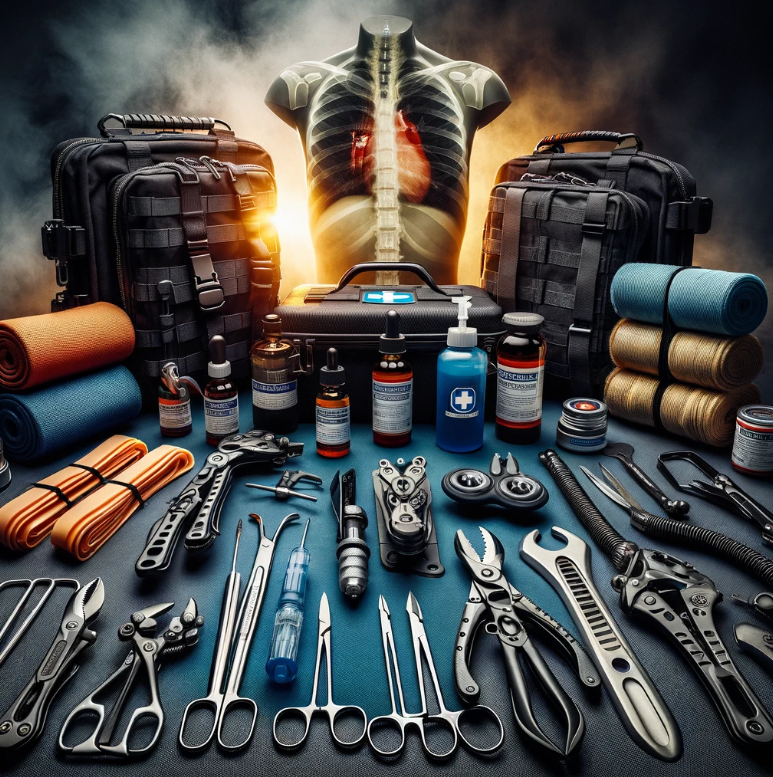
These are crucial for preventing air leaks that can be life-threatening during emergencies. Trauma shears are essential tools for quickly and safely removing clothing or bandages when immediate access is needed to an injury site. splints play a vital role in immobilizing broken bones or injured limbs until professional medical help is available.
- Pros:
- Chest seals prevent air leaks
- Trauma shears allow quick access
- Splints aid in immobilization
- Cons:
- Require proper training
- Limited use without medical expertise
Emergency medications: epinephrine, aspirin, anti-diarrheals
Including epinephrine auto-injectors in your first aid kit is crucial for individuals with severe allergies or facing anaphylaxis. Aspirin serves as a valuable medication during heart attacks by reducing the risk of blood clots forming. Moreover, having anti-diarrheal medications on hand helps manage gastrointestinal issues that may arise unexpectedly during emergencies.
- Key Information:
- Epinephrine aids severe allergies
- Aspirin reduces clotting risks
- Anti-diarrheals manage GI issues
Survival surgery tools: sutures, needles, local anesthetics
For preppers needing to perform minor surgical procedures without professional help available immediately, having sutures and needles becomes essential for wound closure. Including local anesthetics provides temporary pain relief during these procedures but requires adequate knowledge and training before usage.
- Sutures and needles close wounds.
- Local anesthetics offer pain relief.
- Proper training is necessary.
Organizing Your Medical Kit
Categorization strategies for quick access
When organizing your first aid supplies, categorize them into groups like wound care, medications, and tools. This helps you quickly locate what you need in an emergency. Using clear labels or color-coded containers can make identifying different supplies effortless.
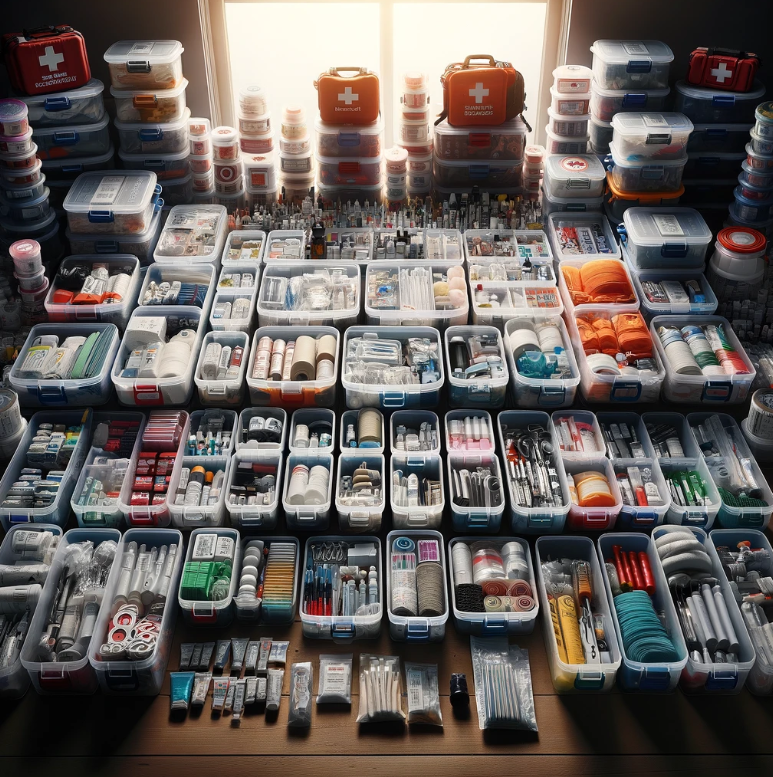
Remember to review and update your organization system regularly to ensure easy access at all times.
- Organize supplies into categories
- Use clear labels or color-coding
- Regularly review and update organization system
Waterproof and durable storage solutions
Select waterproof and durable containers to safeguard your first aid supplies from moisture and damage. Airtight bags or waterproof cases provide extra protection against environmental elements. Splitting supplies into multiple smaller containers aids in both organization and portability.
- Choose waterproof containers
- Consider airtight bags for protection
- Use multiple smaller containers for better organization
Regular maintenance: checking expiry dates, replenishing used items
Regularly check the expiration dates on all medical supplies to replace any expired items promptly. Keep track of used items so that you can restock them immediately to maintain a fully equipped kit. Conduct routine inspections of your first aid kit to ensure it remains up-to-date and ready for use when needed.
- Check expiration dates regularly
- Replenish used items promptly
- Conduct routine inspections
Portable kits for bug-out bags vs stationary kits for home
Portable first aid kits are crucial additions to bug-out bags or evacuation scenarios where mobility is essential. On the other hand, stationary kits kept at home can be more comprehensive with larger quantities of supplies tailored to longer-term needs. Customize each kit based on its intended purpose – whether it’s for immediate evacuation or long-term stay – taking into account the specific requirements of each situation.
- Portable kits are vital in emergencies
- Stationary kits at home offer more comprehensive options
First Aid Skills and Knowledge for Preppers
Basic first aid training: CPR, wound care, fracture management
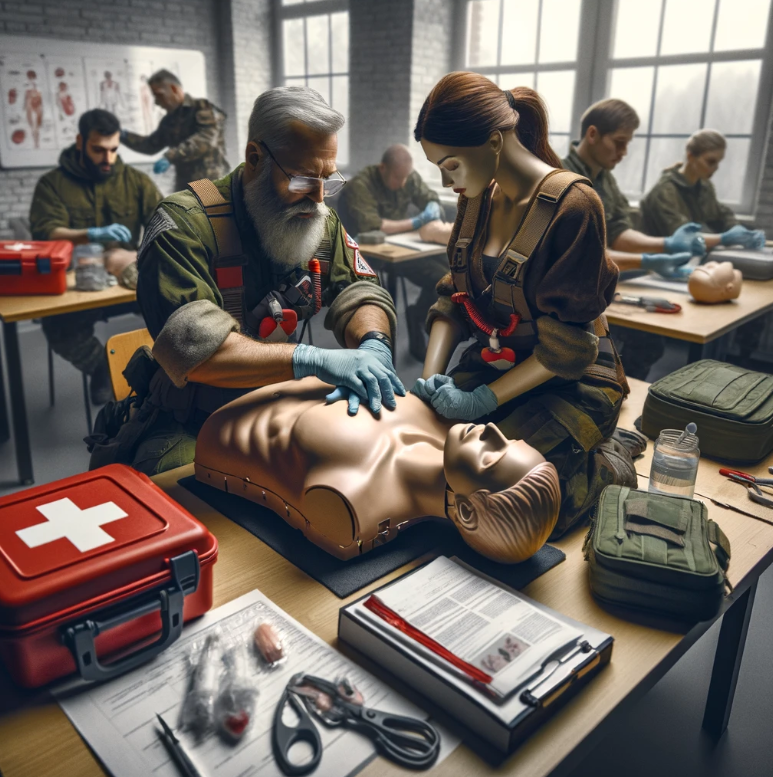
Basic first aid training is essential for preppers as it provides crucial skills like CPR and proper wound care techniques. Learning how to manage fractures, sprains, burns, and other common injuries during emergencies can make a significant difference in saving lives. First aid training courses are widely available through organizations such as the Red Cross or local healthcare providers.
These courses equip individuals with the necessary knowledge to respond effectively in emergency situations.
- Pros:
- Equips individuals with life-saving skills
- Widely available through reputable organizations like the Red Cross
- Cons:
- Basic level of training may not cover all advanced medical procedures
Advanced medical training options offer preppers specialized skills needed in challenging environments. Wilderness first aid courses focus on providing advanced knowledge suitable for remote or outdoor settings. On the other hand, EMT certification offers comprehensive medical training tailored for emergency response situations. Pursuing these advanced medical trainings enhances one’s ability to provide effective care when faced with critical scenarios.
- Pros:
- Offers specialized skills for challenging environments
- EMT certification provides comprehensive medical training
- Cons:
- Requires more time commitment compared to basic first aid courses
Utilizing resources: first aid manuals, online courses, local workshops
First aid manuals serve as valuable references that provide quick guidance during emergencies when immediate access to professional help might be limited. Online courses are convenient options that offer accessible ways of learning essential first aid skills from anywhere at any time. Attending local workshops and community programs not only allows hands-on practice but also creates networking opportunities within the prepper community.
- First Aid Manuals Provide quick guidance during emergencies.
- Online Courses Offer convenient ways of learning essential first aid skills.
- Local Workshops Allow hands-on practice and networking within the prepper community.
Utilizing these resources ensures that preppers have access to vital information and practical experience necessary for responding effectively in emergency situations.
Specialty First Aid and Medical Kits for Different Scenarios
Customizing kits for specific needs: children, elderly, pets
When preparing first aid and medical supplies for preppers, it is crucial to customize kits to meet the unique requirements of different groups. For children, include age-appropriate supplies like colorful bandages or child-friendly medications. Elderly individuals may need items such as hearing aid batteries or larger-sized bandages in their first aid kits.
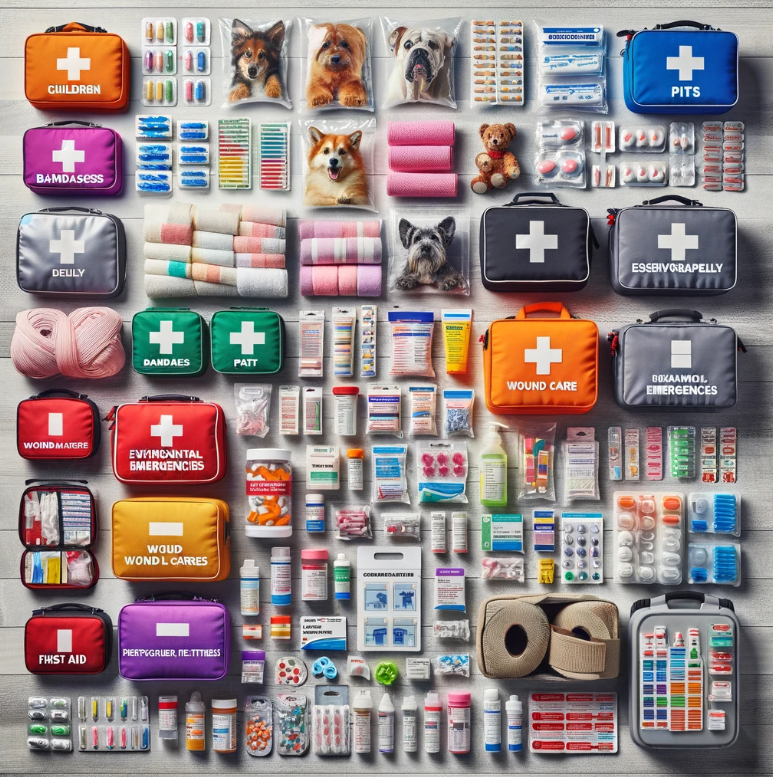
Don’t forget about pets; prepare separate kits with pet-friendly medications and wound care supplies tailored to their needs.
Addressing environmental emergencies is vital when assembling first aid and medical supplies. Be ready to tackle conditions like heat stroke or hypothermia by including emergency blankets, hand warmers, or cooling towels in your kit. Ensure a safe drinking water supply during crises with water purification tablets or filters.
Environmental considerations: heat stroke, hypothermia, water purification
To cater to various scenarios effectively, tailor your first aid kit accordingly. For natural disasters like earthquakes or hurricanes, pack essentials such as trauma dressings and splints. Urban survival situations require items like dust masks and glow sticks due to potential hazards in city environments. Bug-out situations mandate compact and portable kits containing essentials like adhesive bandages and antiseptic wipes for on-the-go sustenance.
Technological Aids and Resources
Apps and online resources for medical emergencies
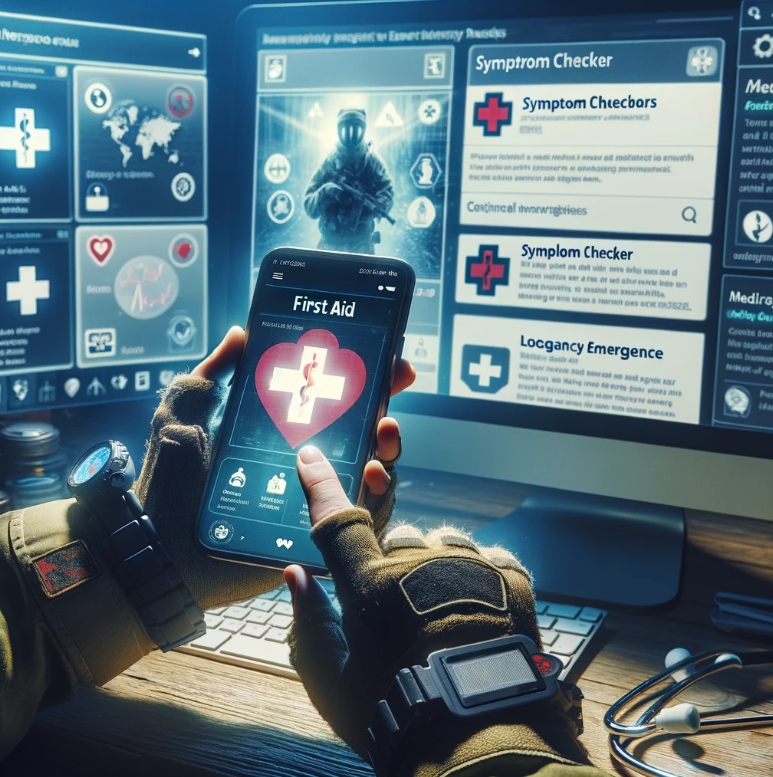
Smartphone apps can provide vital information and guidance during emergencies. These apps offer step-by-step instructions on administering first aid, identifying symptoms, or accessing emergency services promptly. For instance, the Red Cross First Aid app provides tutorials on various medical procedures like CPR or wound care.
Online resources such as websites or forums serve as valuable sources of medical knowledge and advice. Platforms like WebMD or Mayo Clinic’s online resources offer detailed insights into different health conditions, symptoms, and treatment options. By utilizing these digital tools, preppers can stay informed about medical best practices even in remote locations with limited access to healthcare professionals.
The role of technology in enhancing first aid and medical preparedness
Technology plays a crucial role in improving communication channels during emergencies, leading to quicker response times from emergency services. Devices like portable ECG monitors or blood pressure cuffs enable individuals to monitor their health conditions independently when professional care is unavailable. By integrating technological aids into their preparedness plans, preppers can enhance their ability to address medical issues effectively before seeking professional help.
Limitations exist when relying solely on technology post-disaster scenarios due to potential failures in electronic devices’ reliability or accessibility challenges. In cases where power outages occur or network connectivity is disrupted after a disaster strikes, depending solely on technological solutions becomes impractical. Therefore, it is essential for preppers to have alternative non-technological backup plans ready alongside traditional first aid methods for comprehensive emergency preparedness.
Community and Mutual Aid
Building a network for medical knowledge and resource sharing
Connecting with other preppers, healthcare professionals, or local organizations is essential for sharing medical knowledge and resources. By joining online communities or attending local meetings, you can exchange ideas and learn from others’ experiences. This network enhances your ability to access valuable information and support during emergencies.

- Pros:
- Diverse perspectives on medical practices
- Access to a wide range of resources
- Cons:
- Potential misinformation in shared knowledge
- Difficulty coordinating efforts among different groups
Participating in training sessions and drills organized by local prepping groups allows you to practice emergency response skills effectively. Collaborating with like-minded individuals helps simulate realistic scenarios, testing your preparedness level. Engaging in group activities fosters teamwork, improves coordination, and builds confidence in your abilities.
- Key Information:
- Training sessions enhance practical skills
- Drills provide hands-on experience
- Examples:
- Simulating mass casualty incidents
- Conducting triage exercises
The importance of communication in medical emergencies
Effective communication plays a vital role in coordinating emergency response efforts and ensuring proper care during medical emergencies. It is crucial to clearly communicate vital information about injuries, symptoms, or medications to healthcare providers promptly. Practice clear and concise communication skills to facilitate efficient and accurate medical assistance when needed.
- Communicate efficiently with healthcare providers.
- Share detailed information about the situation.
- Ensure all parties involved are informed accurately.
Final Remarks on First Aid and Medical Supplies for Preppers
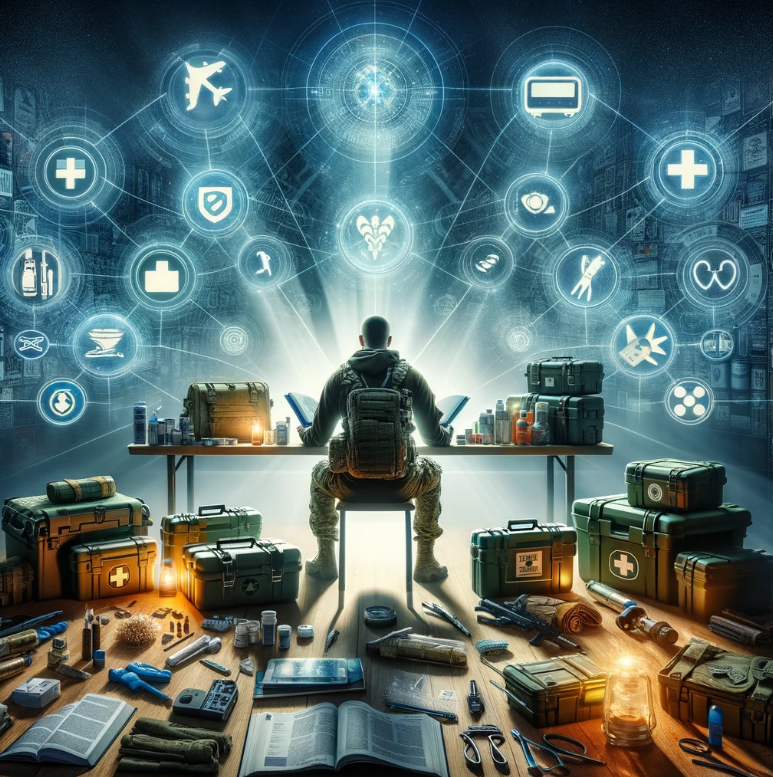
In preparing for unforeseen emergencies, having a well-equipped first aid kit tailored to your needs is paramount. From basic essentials to advanced medical supplies and specialized kits, a comprehensive approach ensures readiness for various scenarios.
Organizing and maintaining your medical supplies, coupled with acquiring the necessary skills and knowledge, enhances your capability to provide effective care when required.
Remember, the effectiveness of your preparedness lies not only in the resources you have but also in how well you can utilize them. Regularly review and update your supplies, practice your skills, and engage with the prepper community to exchange insights and support. By prioritizing continuous learning and adaptation, you bolster your resilience and readiness for any situation.
Frequently Asked Questions
Is it essential for preppers to have a well-stocked first aid kit?
Yes, having a well-stocked first aid kit is crucial for preppers as it ensures they are prepared to handle medical emergencies and injuries in various scenarios.
What are the key items that should be included in a prepper’s first aid kit?
Key items for a prepper’s first aid kit include bandages, antiseptic wipes, pain relievers, adhesive tape, scissors, tweezers, gloves, CPR mask, and medications like ibuprofen and antihistamines.
How can one organize their medical kit effectively?
Organize your medical kit by categorizing items into sections such as wound care supplies, medications, tools/instruments. Use clear pouches or containers labeled with contents for easy identification during emergencies.
Preppers should focus on learning CPR techniques, basic wound care and dressing skills, splinting fractures properly. Additionally gaining knowledge of common illnesses and their treatments is beneficial.
Are there specialized first aid kits available for specific emergency scenarios?
Yes! Specialty kits cater to different scenarios like wilderness survival (snake bites), natural disasters (emergency blankets), or pet-specific kits. These customized kits ensure you’re equipped for specific situations beyond basic injuries.





Your point of view caught my eye and was very interesting. Thanks. I have a question for you.
I might have an answer haha. What’s up?
Pingback: Top 10 Things You Need to Survive in the Wilderness
Pingback: Top 10 Wilderness Survival Tips: Thriving in the Wild